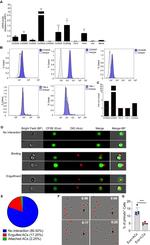Search Thermo Fisher Scientific
Invitrogen
CD365 (Tim-1) Monoclonal Antibody (RMT1-4), eBioscience™
FIGURE: 1 / 1
CD365 (Tim-1) Antibody (14-5861-82) in Flow

Product Details
14-5861-82
Species Reactivity
Published species
Host/Isotype
Class
Type
Clone
Conjugate
Form
Concentration
Purification
Storage buffer
Contains
Storage conditions
Shipping conditions
RRID
Product Specific Information
Description: The RMT1-4 monoclonal antibody reacts with mouse CD365 (also known as TIM1 and HAVCR1) and is a member of the T cell immunoglobulin domain, mucin-like domain (TIM) gene family. CD365 has been found on activated CD4+ T cells, mast cells, and a subset of B cells. CD365 is involved in renal injury, tissue homeostasis, and T cell costimulation. CD365 promotes the differentiation of Th2 cells and the production of IL-4. CD365 can bind several ligands, including Hepatitis A virus, phosphatidylserine, TIM4, IgA, as well as itself. CD365 and TIM4 can mediate uptake of apoptotic cells through recognition of phosphatidylserine. CD365, as well as the other TIM family members, are associated with susceptibility to atopic and autoimmune diseases. In humans, certain polymorphic variants of CD365 are strongly associated with protection against atopy, and this association occurs only in individuals who have had past infection with hepatitis A virus (HAV).
Applications Reported: The RMT1-4 antibody has been reported for use in flow cytometric analysis.
Applications Tested: This RMT1-4 antibody has been tested by flow cytometric analysis of mouse CD365 (TIM1) transfected cells. This can be used at less than or equal to 0.5 µg per test. A test is defined as the amount (µg) of antibody that will stain a cell sample in a final volume of 100 µL. Cell number should be determined empirically but can range from 10^5 to 10^8 cells/test. It is recommended that the antibody be carefully titrated for optimal performance in the assay of interest.
Purity: Greater than 90%, as determined by SDS-PAGE.
Aggregation: Less than 10%, as determined by HPLC.
Filtration: 0.2 µm post-manufacturing filtered.
Target Information
CD365 also known as T-cell immunoglobulin and mucin domain 1 (Tim-1) is a type 1 surface glycoprotein that consists of extracellular N-terminal immunoglobulin V-like domain and a mucin domain, and a short cytoplasmic tail. The endogenous ligand for CD365 is Tim-4. In addition, CD365 is known to be a cellular receptor or co-receptor for a number of viruses including hepatitis A and C viruses, Ebola virus, Marburg virus, Dengue virus, Zika virus, West Nile virus, and Japanese encephalitis virus. The direct binding of the viruses by CD365 occurs via phosphatildyl-serine exposed on viral envelopes. Polymorphisms within human CD365 gene (HAVCR1) are associated with susceptibility to infection and the disease severity. CD365 has also been implicated in the T cell co-stimulation. CD365 is primarily expressed in epithelial cells. It is also highly expressed in A549, 769-P and Caco-2 and cell lines. CD365 exists also as a soluble protein generated by metalloproteinase mediated proteolytic cleavage of the surface protein.
For Research Use Only. Not for use in diagnostic procedures. Not for resale without express authorization.
Bioinformatics
Protein Aliases: CD365; HAVcr-1; Hepatitis A virus cellular receptor 1 homolog; Kidney injury molecule 1; KIM-1; T cell immunoglobulin and mucin domain-containing protein 1; T cell membrane protein 1; T-cell immunoglobulin and mucin domain containing 1; T-cell immunoglobulin mucin receptor 1; TIM-1; TIMD-1
Gene Aliases: AI503787; Havcr1; KIM-1; Kim1; TIM-1; Tim1; Timd1
UniProt ID: (Mouse) Q5QNS5
Entrez Gene ID: (Mouse) 171283

Performance Guarantee
If an Invitrogen™ antibody doesn't perform as described on our website or datasheet,we'll replace the product at no cost to you, or provide you with a credit for a future purchase.*
Learn more
We're here to help
Get expert recommendations for common problems or connect directly with an on staff expert for technical assistance related to applications, equipment and general product use.
Contact tech support
